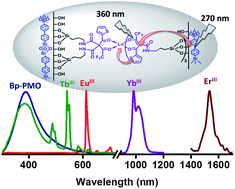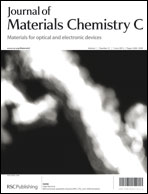A hierarchically ordered 4,4′-biphenylene-bridged mesoporous organosilica framework (Bp-PMO) has been synthesized with the aim of using it as a new hybrid host for LnIII ions. A series of novel organic–inorganic luminescent hybrid materials have been obtained by covalently linking LnIII complexes (Ln = Eu, Gd, Tb, Er, and Yb) to Bp-PMO functionalized with 2-thenoyltrifluoroacetone (HTTA). The visible and NIR photoluminescence studies of the hybrid materials show that Bp-PMO acts both as an inorganic host and an organic co-sensitizer for LnIII ions. The intrinsic quantum yield and lifetime data obtained for the hybrid material containing EuIII (54.5% and 615 μs) are among the highest values reported for hybrid materials containing EuIIItetrakis(β-diketonate) complexes. The combination of Bp-PMO and HTTA also provides sizable sensitization for TbIII, ErIII and YbIII ions. The overall quantum yields and lifetime measurements for mixed metallic hybrid materials show that Ln → Ln′ energy transfer occurs in the mixed lanthanide systems. In addition, controlling the Ln/Ln′ ratio allows one to tune the emission colour.

You have access to this article
 Please wait while we load your content...
Something went wrong. Try again?
Please wait while we load your content...
Something went wrong. Try again?


 Please wait while we load your content...
Please wait while we load your content...